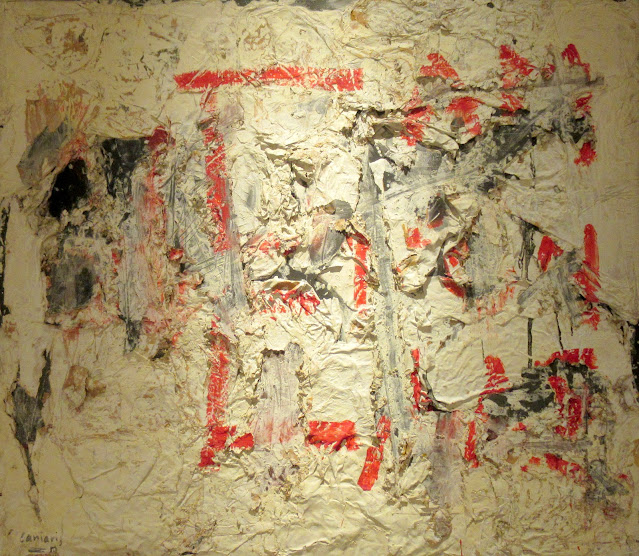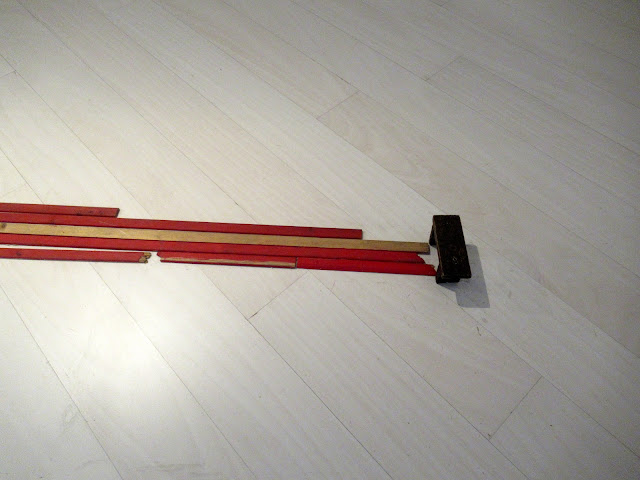
Will by Penny Siopis at the National Museum of Contemporary Art, Athens.
This is the second part of the Penny Siopis - For Dear Life exhibition that we saw in September. It is also part of the What If Women Ruled the World? series of exhibitions at EMST.

Will, 1997 - ongoing, (collected objects, texts by the artist)
Will, an ongoing conceptual work begun in 1997, comprises over 700 found objects from the artist's collection, and functions as an ultimate timepiece. Siopis sees it becoming alive only on her death: she has singled out objects from her vast collection and bequeathed them to individuals all around the world. Upon her passing they will be sent out to their recipients. Seen as an autobiographical project this particular collection also functions as an archive and inventory of both personal and collective history.
The work comments on the lives and perceptions of objects that could function both as art and heirloom, representing different values for those who possessed them before the artist and those who will end up owning them in the future. Each object is presented with a short caption giving a brief story of its history and associations, recounted by the artist in the voice of the third person. Will presupposes an end through its own fragmentation. It will continue living as a memory; at the same time the objects, having been dispersed, will acquite new meanings that have the potential to continue to evolve forever.
I found the collection of objects fascinating, not least because they tell us so much about apartheid in South Africa, so I am including this installation in a separate post as the previous one was so long.
Decorated leather holster of Tickey the Clown
Tickey was a famous clown from Boswell's Circus that toured South Africa in the 20th century. Tickey (Eric Hoyland) got his nickname from the smallest coin in the country because he was a small person. He performed between 1933 and 1965. Boswell's Circus was known for breaking the apartheid ban on Sunday entertainment and performing for racially diverse audiences. Artist met Tickey when the circus came to Vryburg.
Object for a project on 'Critiquing Representation'. Artist intended to chip away at the chips already inherited on the boy's face, so that only white plaster would remain. The project was never completed.Baby buck
Stuffed baby buck bought at an auction of the estate of artist's neighbour who had been murdered in her bed in Johannesburg. Artist was the only bidder.
Blue head from tableau for artist's 1994 exhibition 'Private Views'. Except for her 'staring blue eyes' she is coated in Reckitt's Blue, a pigment powder commonly added to washing detergent to make white laundry 'whiter than white'. Sometimes it is just called 'Blue'. The powder can be used for 'bluing' the skin for disguise or as protection against the Evil Eye. Carry Blue head by her hair.
'The Star' newspaper, 8 September 1966
The face of Demitrios Tsafendas who assassinated South African Prime Minister and architect of apartheid VF Verwoerd in Cape Town in 1966. Tsafenda's story inspired artist's film Obscure White Messenger.
'Teach yourself Zulu' records and manual
Records and accompanying manual sharing the subtitle 'The musical language rich in idiom', for beginners.
Swedish anti-patriarchy T-shirt
Swedish for 'Crush Patriarchy'. Artwork made to wear and act. Gift to artist from student at Konshogskolen, Umea, Sweden, in 2000.Greek dictionary
Lexicon. Belonged to artist's mother who kept it in her bag to help her with troublesome words.
Sisonke Msimang's 'Rescuing Mandela from Sainthood'.
Sisonke Msimang, daughter of revolutionaries who grew up moving from place to place in exile, reflects on Mandela by taking the role of what she terms the 'sister outsider', after Audre Lorde. 'I am paying him tribute of course, but also giving voice to some of what troubles me about how he is viewed today...'
St Escrava Anastacia
The only example artist has seen of a saint presented in chains and scold's bridal (medieval torture instrument used to stop women from speaking). Acquired by artist in Portugal in 1997, but cast in Brazil.
Banned 'Labour Bulletin'
Such banned literature was kept by artist behind the row of books on still-life painting on her shelf. No female nudes! Policemen would be too keen to examine their content.
'Ikhono LaseNathali' tote
isiZulu loosely translated as 'Talent from KwaZulu-Natal'. Gift from Zanele Muholi's 2018 project at A4 Foundation in Cape Town where they invited 25 emerging artists to interpret their self-portrait series 'Somnyama Ngonyama'. The project aimed to redirect global acclaim to other artists. 'As a visual activist, I took it upon myself with my own funds to share wealth, give artists an opportunity to create and now we are exhibiting the work', Muholi says.Struggle T-shirt
Gifted to artist by banned friend in 1989. Under apartheid you could be charged, banned and imprisoned for wearing a protest T-shirt like this.
EFF beret
Beret of a member of the Economic Freedom Fighters, a South African Marxist-Leninist black nationalist political party. Found in a Jewish thrift store in Sea Point, Cape Town.
'Samba with Ros' record
Trinidadian-born band leader Edmundo Ros popularised Samba in the 1940s. Loved and danced to by artist's mother. Officially Samba is Brazilian but its beats arrived there with African slaves. Samba marks carnival all over the world. In South Africa it echoed in Shakira's Waka Waka anthem for the 2010 Soccer World Cup. Local artists accused Shakira of stealing their musical phrasing. Zolani Mahola, of local band Freshlyground, sang her 'Waka' part nonetheless, but in isiXhosa.
TRC comic book
Introduction to the Truth and Reconciliation Commission in the style of a comic book. On the cover: 'One afternoon at a community centre somewhere in South Africa, Ma Ngubane is telling her story....'
'The Hand that Rocks the Cradle' postcard
Personal message to artist from Colin Richards in London, dated 6.10.88. Card published by Oxfam with inscription 'quote from the Conference at the end of the UN Decade for Women'. The phrae is a twist on the title of a poem by 19th-century American poet William Ross Wallace,' 'The hand that rocks the cradle is the hand that rules the world', 1865.
Holy Land gift
Gift of olive oil, holy incense, holy earth and holy water in four discrete vials from Jennifer Law after her sojourn in Jerusalem. The vials are accompanied by a certificate of authenticity.Robben Island rock
A piece of limestone said to come from the actual quarry where Nelson Mandela laboured on Robben Island and which damaged his eyes, making it impossible for him to shed tears.
Grief music 45 RPM record
'Prayer in memory'. Gift from Korean artist in Gwangju, 1995. Composer is Takahashi Yuji. Commemorates the 'People's Uprising' in Gwangju, 1980. A poem is in the insert. Artist recalls fragments: 'Birds cried and barely wept ... the spirit of dead becomes raindrops which will wet dry minds and bring forth buds ... the raindrops will crush solid stone'.
British army WWII gas mask
Issued to soldiers for protection against poison gas. Inside the box respirator was a charcoal filter and gauze which was mixed with chemicals to neutralise the gas. Animals also wore masks.
Ceramic cup commenmorating Zambian independence
Ceramic marking Zambia's independence from the British who governed the region (as Northern Rhodesia) as a 'British Protectorate'. Colonial rule began in 1888 when the British South African Company secured mineral rights in the area.
Remnants of burnt South African police cap
Retrieved by artist during an anti-apartheid demonstration in 1987 on the campus of the University of the Witwatersrand, outside the Great hall.
'My Ballot my History' cap
Democracy cap, where X is the mark that reminds citizens of their rights.
Gold-painted Gandhi
Gold-painted plaster. A play-Oscar for the film 'Gandhi', won in 1983? or a memorial to Gandhi's fight for justice commemorating an incident in DwaZulu-Natal on June 7 when Gandhi was thrown off a train carriage that he boarded knowing it was reserved for whites. One of his first acts of Passive Resistance.
St Helena Gold Mine 'Boss boy' arm band
An African foreman on the gold mines in South Africa would have to wear this insult and bear the injury. Gold was 'discovered' in 1986. Mining rapidly industrialised the region on the backs of black labour. St Helena mine was established in the town of Welkom in 1946 - 'welkom' meaning welcome in Afrikaans. Visitors today can experience its working through conducted tours, and witness a shaft that is now the world's deepest wine cellar.
Eastern European ration book
Soviet ration book. Bought in the early 1990s by artist's friend in Johannesburg and presented as a gift. Seller had claimed to be a refugee from the Eastern bloc but denied ever having been rationed.






































































